Great Pyramid of Giza
Table of Contents
The Great Pyramid of Giza (also called the Pyramid of Khufu and the Pyramid of Cheops) is the oldest and largest of the three pyramids in the Giza Necropolis bordering what is now El Giza, Egypt. It is the oldest of the Seven Wonders of the Ancient World, and the only one to remain largely intact.
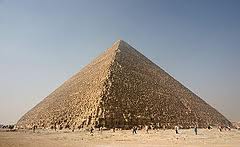 Initially, at 146.5 meters (480.6 ft), the Great Pyramid was the tallest man-made structure in the world for over 3,800 years, the longest period of time ever held for such a record.
Initially, at 146.5 meters (480.6 ft), the Great Pyramid was the tallest man-made structure in the world for over 3,800 years, the longest period of time ever held for such a record.
Hanging Gardens of Babylon
The Hanging Gardens of Babylon were built in the ancient city-state of Babylon, near present-day Al Hillah, Babil, in Iraq. They are sometimes called the Hanging Gardens of Semiramis in reference to the legendary Queen Semiramis.
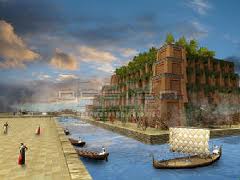 The gardens were supposedly built by the Babylonian king Nebuchadnezzar II around 600 BC. He is reported to have constructed the gardens to please his homesick wife, Amytis of Media, who longed for the trees and fragrant plants of her homeland. The gardens were destroyed by several earthquakes after the 2nd century BC.
The gardens were supposedly built by the Babylonian king Nebuchadnezzar II around 600 BC. He is reported to have constructed the gardens to please his homesick wife, Amytis of Media, who longed for the trees and fragrant plants of her homeland. The gardens were destroyed by several earthquakes after the 2nd century BC.
Statue of Zeus at Olympia
The Statue of Zeus at Olympia was made by the Greek sculptor Phidias, circa 432 BC on the site where it was erected in the Temple of Zeus, Olympia, Greece.
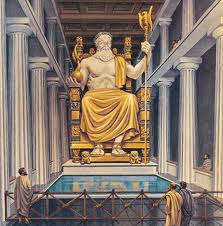 The seated statue, some 12 meters (43 feet) tall, occupied half of the width of the aisle of the temple built to house it.
The seated statue, some 12 meters (43 feet) tall, occupied half of the width of the aisle of the temple built to house it.
The sculpture was wreathed with shoots of olive worked in gold and seated on a magnificent throne of cedarwood, inlaid with ivory, gold, ebony, and precious stones. In Zeus’ right hand there was a small statue of crowned Nike, goddess of victory, also chryselephantine, and in his left hand, a scepter inlaid with gold, on which an eagle perched.
Temple of Artemis at Ephesus
The Temple of Artemis, also known less precisely as the Temple of Diana, was a Greek temple dedicated to a goddess Greeks identified as Artemis. It was situated at Ephesus near the modern town of Selçuk in present-day Turkey and was completely rebuilt three times before its eventual destruction in 401.
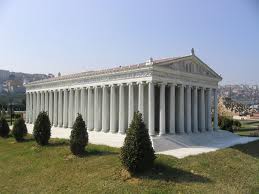 The first sanctuary antedated the Ionic immigration by many years and dates to the Bronze Age. Callimachus, in his Hymn to Artemis, attributed it to the Amazons. In the seventh century, the old temple was destroyed by a flood. Its reconstruction began around 550 BC, under the Cretan architect Chersiphron and his son Metagenes, at the expense of Croesus of Lydia: the project took some 120 years to complete, only to be destroyed in an act of arson by a young arsonist seeking fame named Herostratus. It was later rebuilt.
The first sanctuary antedated the Ionic immigration by many years and dates to the Bronze Age. Callimachus, in his Hymn to Artemis, attributed it to the Amazons. In the seventh century, the old temple was destroyed by a flood. Its reconstruction began around 550 BC, under the Cretan architect Chersiphron and his son Metagenes, at the expense of Croesus of Lydia: the project took some 120 years to complete, only to be destroyed in an act of arson by a young arsonist seeking fame named Herostratus. It was later rebuilt.
Mausoleum of Maussollos at Halicarnassus
The Mausoleum at Halicarnassus or Tomb of Mausolus was a tomb built between 353 and 350 BC at Halicarnassus present Bodrum, Turkey for Mausolus, a satrap in the Persian Empire, and Artemisia II of Caria, his wife, and sister.
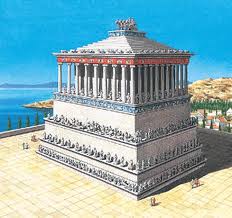 The structure was designed by the Greek architects Satyros and Pythias. It stood approximately 45 m (148 ft) in height, and each of the four sides was adorned with sculptural reliefs created by each one of four Greek sculptors Leochares, Bryaxis, Scopas of Paros and Timotheus. The finished structure was considered to be such an aesthetic triumph that Antipater of Sidon identified it as one of his Seven Wonders of the Ancient World.
The structure was designed by the Greek architects Satyros and Pythias. It stood approximately 45 m (148 ft) in height, and each of the four sides was adorned with sculptural reliefs created by each one of four Greek sculptors Leochares, Bryaxis, Scopas of Paros and Timotheus. The finished structure was considered to be such an aesthetic triumph that Antipater of Sidon identified it as one of his Seven Wonders of the Ancient World.
Colossus of Rhodes
The Colossus of Rhodes was a statue of the Greek Titan Helios, erected in the city of Rhodes on the Greek island of Rhodes by Chares of Lindos between 292 and 280 BC.
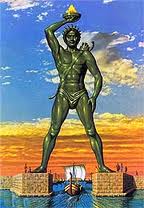 It was constructed to celebrate Rhodes’ victory over the ruler of Cyprus, Antigonus I Monophthalmus, who unsuccessfully besieged Rhodes in 305 BC. Before its destruction, the Colossus of Rhodes stood over 30 meters (107 ft) high, making it one of the tallest statues of the ancient world.
It was constructed to celebrate Rhodes’ victory over the ruler of Cyprus, Antigonus I Monophthalmus, who unsuccessfully besieged Rhodes in 305 BC. Before its destruction, the Colossus of Rhodes stood over 30 meters (107 ft) high, making it one of the tallest statues of the ancient world.
Lighthouse of Alexandria
The Lighthouse of Alexandria, also known as the Pharos of Alexandria, was a tower built between 280 and 247 BC on the island of Pharos at Alexandria, Egypt. Its purpose was to guide sailors into the harbor at night time.
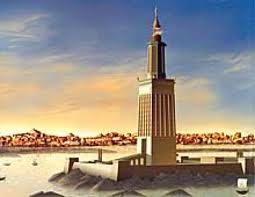 With a height variously estimated at somewhere in-between 393 and 450 ft (120 and 140 m), it was for many centuries among the tallest manmade structures on Earth.
With a height variously estimated at somewhere in-between 393 and 450 ft (120 and 140 m), it was for many centuries among the tallest manmade structures on Earth.
